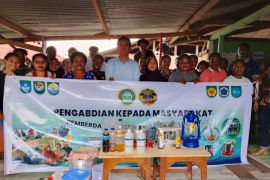Jambi has 2,107,745 hectares of forest, according to a survey by the Executive Board of REDD of the Republic of Indonesia, the Jambi provincial administration and the UNDP.
In addition, there were 883,000 hectares of forests which have been converted in status from primary to secondary forests.
Degradation of forests were recorded in locations which have been declared as wildlife reserve and protected forests.
Around 136,000 hectares of natural forests and 56,000 hectares of protected forests have been degraded in the province, the survey said.
Head of the Unit of Government Management System and Poverty Eradication of UNDP Indonesia, Nurina Widagdo, said the forest destruction is potential to slash the government income from the forestry sector.
"The government income is not proportional with the fund spent for the rehabilitation of forests," Nurina said after the launch on Monday of a book about Forest Management in regencies in Jambi.
The government income was Rp19 billion from the forestry sector in Jambi and Rp21.6 billion in reforestation fund as against Rp15.8 trillion spent for the rehabilitation of damaged forests in that province.
The spending was for the rehabilitation of 934,000 hectares of damaged forests . Around Rp17 million, therefore, are needed for the rehabilitation of 1 hectare of forest.
Damaged forests would take 752 years to full recovery, the survey said.
Rehabilitation of 883,000 hectares of forests from secondary to primary forests would cost Rp4.4 trillion or around Rp5 million per hectare.
Meanwhile, the government has only the capacity to rehabilitate 7,250 hectares of damaged forests a year which means 128 years would be needed to wrap up the process of rehabilitation of 934,000 hectares of damaged forests .
Nurina said the survey by the team of experts chaired by Prof Dr Hariadi and Dr Sunaryo from UNDP, showed the Forest Management System Index in Jambi was not yet adequate.
"The average index of forest management system in Jambi is far from being ideal. The index averaged only 33.37 percent in the 9 regencies in Jambi," she said.
The highest index was 39.87 percent recorded by the regency of Merangin , followed by the regency of Batanghari with index of 38.23 percent , regency of Kerinci 38.04 percent, she cited.
The policy acknowledging traditional and village forests in the three regencies was among the factors of evaluation in other regencies.
In the regency of Kerinci, there are nine nine traditional forests and three of them are in the process of seeking recognition by the district administration.
In the regency of Merangin , there are 17 village forests totaling 45,000 hectares.
In other regencies there are five village forests on the average.
Involvement of traditional institutions in settling conflicts between local people and forestry companies is an advantage in the evaluation for the regency of Batanghari. The traditional institution is considered effective in settling such conflict.
The lowest index of 23.35 percent was recorded by the regency of Tanjung Jabung Timur , followed by the regency of Muaro Jambi with index of 25.68 percent and Tanjung Jabung Barat 28.67 percent.
The survey said there has been no breakthrough in the forest management system in the three regencies. In addition, there was no attempt to improve transparency and integrity in in forest management.
It also said exploitation of forests are dominated by companies. Companies utilized 93 percent or 1,646,250 hectares of forests in Jambi including natural forests, borrowed forests by mining and oil and gas companies . The local people use only 116.66 hectares including 38,526 hectares of village forests , 49,703 hectares of community forests and 28,439 hectares of peoples plantation forests.
(AS/O001)
Editor: Ella Syafputri
Copyright © ANTARA 2014











